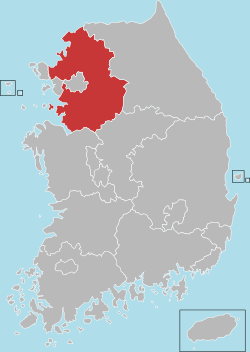Pyeongtaek
| Pyeongtaek 평택시 | ||
|---|---|---|
| Municipal City | ||
| Korean transcription(s) | ||
| • Hangul | 평택시 | |
| • Hanja | 平澤市 | |
| • Revised Romanization | Pyeongtaek-si | |
| • McCune-Reischauer | P'yŏngt'aek-si | |
 | ||
| ||
 Location in South Korea | ||
| Country |
| |
| Region | Sudogwon | |
| Administrative divisions | 4 eup, 5 myeon, 13 dong | |
| Area | ||
| • Total | 452.31 km2 (174.64 sq mi) | |
| Population (2012 Jan) | ||
| • Total | 427,460 | |
| • Density | 945/km2 (2,450/sq mi) | |
| • Dialect | Gyeonggi | |
Pyeongtaek is a city in Gyeonggi Province, South Korea. Located in the southwestern part of the province, Pyeongtaek was founded as a union of two districts in 940, during the Goryeo dynasty. It was elevated to city status in 1986, and is home to a South Korean naval base and a large concentration of United States troops. The Korean government plans to transform Pyeongtaek city to an international economic hub to coincide with the move of the United States Forces Korea (USFK) to Pyeongtaek. During the Korean War it was the site of an early battle between US and North Korean forces, the Battle of Pyongtaek. It is the location of Pyeongtaek University.
Military base
The United States and South Korean governments came to an agreement to enlarge Camp Humphreys — a US Army installation outside Anjeong-ri, a community in Pyeongtaek — and move the majority of US forces stationed in and north of Seoul to the Camp Humphreys area. Invoking eminent domain, the government obtained the surrounding land for the base expansion. This would result in the community's third displacement from their own land since the Japanese occupation during World War II.[1]
The move originally included the headquarters of the Combined Forces Command, which has operational control of ROK (Republic of Korea), US, and UN combined forces during wartime. In March 2007, US Defense Secretary Robert Gates and ROK Minister of Defense Kim Jang-soo agreed to dissolve the ROK-US Combined Forces Command on April 17, 2012.[2] This would allow ROK forces to have wartime control of its military during a military confrontation with the North. The US/ROK agreement allows USFK to move to one centralized location away from the congestion of Seoul and its surrounding areas. This relocation agreement results in returning two-thirds of the land currently used by the United States Military back to the Korean government. By 2008, the US military was to have consolidated 41 installations down to 10 due to the relocation agreement. USFK's only jail facility in South Korea is at Camp Humphreys.
Osan Air Base is in Songtan, a district in Pyeongtaek City.
Education
The city's sole international school is Pyeongtaek International Christian School (평택크리스천외국인학교).[3]
Notes
- ^ U.S. Move Is Spurring Evictions In S. Korea (Washington Post article)
- ^ Massive Force Mobilized to Evict U.S. Base Protestors (Chosun Ilbo article (English))
- ^ Activists Are Only Using the People of Pyeontaek (Chosun Ilbo English Editorial) article
- ^ More Violence Looms in Planned Rally at U.S. Base Site
- ^ U.S. base expansion in Korea sparks protests (Socialism and Liberation) article
See also
References
- ↑ http://news.bbc.co.uk/2/hi/asia-pacific/6389553.stm Eviction village: A farmers tale
- ↑ Changes to Wartime OPCON: Challenges for the ROK, Chosun
- ↑ "Pyeongtaek International Christian School." International School Information (Government of South Korea). Retrieved on March 30, 2016.
External links
| Wikimedia Commons has media related to Pyeongtaek, Gyeonggi-do. |
- Pyeongtaek City Website in English
- South of Seoul: Pyeongtaek Based Restaurants & Things to Do
- MollaKorea: Community website for foreigners living in Pyeongtaek Area
Coordinates: 36°59′32″N 127°06′46″E / 36.992236°N 127.112821°E

